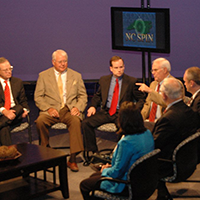Where are we on the inflation battle?
Published May 22, 2025
Price inflation was one of the top issues in the 2024 presidential election. People were tired of seeing big price jumps, especially if those increases were more than their income rose. Candidates promised that – if elected – inflation would be reduced.
Recently the latest inflation rate was released. The report was cheered by many because the annualized rate of 2.3% was the lowest in four years.
But, as I have stressed in previous columns, “reducing inflation” does not mean “reducing prices.” Inflation measures the rate at which the average of prices is changing. Typically, the inflation rate is positive, meaning the average of prices is rising. Historically, the only time average prices fall is during bad economic times, like recessions and depressions. Of course, individual prices, especially for food and fuel, often move both up and down.
What really matters to people is whether their incomes keep pace with rising prices. During the recent surge in inflation, especially in 2021 and 2022, price increases clearly outpaced household income gains. In those years prices rose 5 percentage points faster than worker earnings, the measure I use for household income.
The good news is the gap between changes in prices and changes in worker earnings has improved in favor of households in recent years. In 2023, 2024, and so far in 2025, average worker earnings have gone up more than the average of prices.
But the situation comparing inflation and household income could be better. In the decade prior to the pandemic from 2010 to 2020, annual average prices rose 1.7% and annual average worker earnings increased 2.7%. There was only one year in which the gain in average worker earnings did not exceed the inflation rate.
If we want to return to the inflation situation we had in the 2010s decade, then we need a lower annual inflation rate under 2%, or we need faster gains in worker earnings. Here I will stick to the goal of a lower inflation rate. What will it take to get to an annual inflation rate like the 1.7% rate of the 2010s?
First, let’s see where higher price inflation is occurring. Because we buy them on a regular basis – usually weekly – let’s begin with food and fuel. Food prices can be subject to big swings due to shifts in supplies at the farm level. Most of us are aware of the surge in egg prices due to the avian flu. Beef prices have also jumped as a result of several years of drought in major beef raising states. But rising food prices in grocery stores and supermarkets have actually moderated in the early months of this year compared to the same months last year. Food prices are up just a little over 2%.
Gas prices are another good news item for consumers. Gas prices (price per gallon) have trended downward for almost three years, with a total drop of $1.30 a gallon for a reduction of 27%. These are national numbers, so local variations can make individual experiences different. But with proposals to increase domestic oil production, and with the recent announcement by oil-producing countries in the Middle East to increase production, the outlook is for even lower pump prices. There are some forecasts of another 10% drop in gas prices over the next eighteen months.
So, what’s keeping the inflation rate stubbornly higher than the Federal Reserve’s 2% goal, and likely an even lower goal by most of us? To answer this question, I looked at the annual inflation rate of various spending categories for the first three months of 2025 compared to the same months in 2024.
I found three categories have had significantly higher inflation rates than other categories. They are electricity, shelter, which includes both homeowning and renting, and hospital services. Indeed, not only did these three categories have higher inflation rates in the most recent year, but they also had higher rates during the previous year.
Fundamentally, price increases occur when there is an imbalance between buying and supply. Specifically, when people try to buy or use more of a product or service than is available, the price increases. Each of the three categories – shelter, hospital services, and electricity – are in situations where usage is rapidly increasing. As our population grows – particularly in North Carolina – it can be a challenge for housing construction to keep up with more households. Debates about zoning and regulations also are factors. We are also an aging society, which means greater use of medical and hospital services. But again, building new hospitals and training more doctors can be lengthy processes. Last, our economy largely runs on electricity. With new uses for electricity, including electric vehicles and artificial intelligence, occurring, electricity usage can easily outpace electricity availability.
There has been good progress made in reducing the pace at which average prices are increasing. An inflation rate of 2.3% is certainly better than the rate of 9% we experienced a couple of years ago. More workers are also seeing their paychecks keeping pace with prices.
But the inflation battle appears not to be totally won. Typically, we rely on the Federal Reserve and the federal government to take the lead in controlling inflation. But with many of the factors behind today’s inflation rate linked to state and local situations and decisions, maybe the inflation battle needs more fighters. You decide.
Walden is a William Neal Reynolds Distinguished Professor Emeritus at North Carolina State University.







